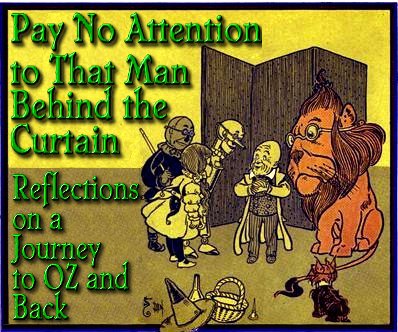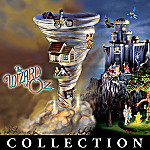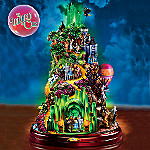 | |||
 |
 |  | |
 |  | ||
 |  | ||
 |  | ||
 |  | ||
 | |||
 |
 |  | |
 |  | ||
 |  | ||
 |  | ||
 |  | ||




|
Pay No Attention to That Man Behind the Curtain - Reflections on a Journey to Oz and BackAs I've mentioned in my newsletters, our family was kept very busy from November, '08 through March, '09, with two high school plays: A Christmas Carol and The Wizard of Oz (the stage play based on the MGM musical version). Shelia did costumes and scrounged up many of the props, I did mostly set painting, and Molly did all of the above in addition to playing Mrs. Cratchit, Auntie Em, and countless other roles, including a tree, a poppy, a caroler, and a beautician.I am no artist. But I had acquired a few basic skills while working on previous projects, large and small. Those skills came in very handy, such as when we needed several different kinds of wainscotting panels for set pieces in Carol. I was mostly making it up as I went along, and when things came out fairly well, I was almost as surprised than anyone else. Although the core of this article is about something else, this is the procedure we figured out, in case you wondered.
During all of these exercises, I was aided by the play's then seventeen-year-old director, producer, and set designer, who is planning to study directing in college. He helped as I figured out where to draw the light and shadow, creating a simplified 3D effect that imitated To keep my sanity during such exercises, I always assume that the light source is coming from the upper left (about 10:30 if you will). I mixed a lighter color than the background to paint where the "light" would be hitting an edge of the board or panel (the upper and left edges). I mixed a darker color to paint where the board or panel would be casting a shadow (the lower and right edges). The middle panel above actually put the imaginary light source at 1:30, which works out, too. We just have to be careful not to have both "light angles" on the same set piece.
For the window pane's "base" coat, I used a muddy brown that I had made up accidently while painting something else. (If you've worked extensively with acrylic and latex paints, you know that muddy brown is the default whenever you mix too many different colors together.) I then used my builders' square to draw the outline of the frames, then used a cheap flat white spray paint to make backwards "L" shapes where the frost would be. Since the window would be set "into" the wall, the outside edge of the frame had to be shaded "backwards" from what I might usually do - the top and left edges would be darker (to represent "shadow"), and the lower and right edges would be brighter (to represent light hitting them). The resulting "window" was just paint on cardboard, but it was so effective that from the time I screwed it onto the painted "brick" set piece, folks walking past kept doing double-takes when they got close enough to realize it was a "painting," not a real window. Of course, theater has a 30-foot rule, instead of garden railroading's unspoken "ten-foot rule," but many principles still apply.
Why am I telling you this? For three reasons:
Was Oz Really an "Ordinary Man"? Where does the "Man Behind the Curtain" come in? As you'll recall, the "Wizard" was a two-bit sideshow performer/snake-oil salesman, whose accidental arrival in Oz must have reframed an ongoing "cold war" between the good and bad witches. By allowing the natives to assume that he also had supernatural powers (and later taking pains to act the part), he was able to ally with the good witches and intimidate the bad witches into leaving central Oz alone long enough to build an impressive city with a very happy citizenry. Where does the "Man Behind the Curtain" come in? As you'll recall, the "Wizard" was a two-bit sideshow performer/snake-oil salesman, whose accidental arrival in Oz must have reframed an ongoing "cold war" between the good and bad witches. By allowing the natives to assume that he also had supernatural powers (and later taking pains to act the part), he was able to ally with the good witches and intimidate the bad witches into leaving central Oz alone long enough to build an impressive city with a very happy citizenry.
Okay, you have to read between the lines to get all that, but think about it - even without magic powers, Oz is a remarkable person with one tragic flaw - until the Wicked Witch of the West is dead, Oz can not keep his people safe without pretending to be something he, patently, is not. When Oz's cover is finally blown, he seems almost relieved to shed the deception, but Dorothy and her friends are bitterly disappointed - Dorothy most of all because she has been counting on his supernatural abilities to send her home. Do People Really Want to See Behind the Curtain?What I've discovered, after many years, is that many people don't want to see behind the curtain. Folks actually like to imagine that someone out there is smarter or better than them, and they're often disappointed when they learn otherwise. The strongest example may be the person who demands to know the secret behind a "magic trick" and then is disappointed that it is so simple, sometimes even getting a little angry that he was "taken in." In garden railroading, this translates into statements like "Look at that magnificent waterfall/trestle/structure/evergreen forest! I could never build anything like that." I used to think this sort of statement meant that the speaker was intimidated by something impressive, but of late, I've learned that such statements often mean "No way I'm going to take on a project of that size." Worse yet, if you take the time to show the person that it really isn't that hard, as often as not, they seem disappointed that there is no secret except planning, hard work, and following a few simple instructions. What if There Really Aren't Any "Secrets"?Since 1996, we've been trying to tear down barriers to folks who want to have a garden railroad in their back yard. And we've been pretty successful. (Check out our Testimonials page in case you're in doubt about that.) We've written about one or two things that look easy and are really hard to do right unless you have the right information, and we've written about dozens of things that look hard and are really very easy, once you learn the "trick."One example is a trestle, an elaborate-looking construction that always draws comments, but can be built by anyone who can handle simple power tools and follow our free instructions. At clinics, where people have ostensibly come to learn, I sometimes show a simple trestle jig and let someone from the audience bang a trestle "bent" together to see how easy it is. Those folks always leave excited about the possibilities. But when someone visiting my railroad asks about trestles, and I show them how it's done, they almost inevitably seem disappointed. "Why, any idiot could do that," seems be written in their expression. I've encountered the same expression in many other circumstances:
Sharing Information Can Be DangerousIt's not that I'm good at that many things; it's just that when I've figured something out that can help other people, my natural instinct is to share. The worst case of shooting myself in the foot this way was probably when I figured out a way a division at work could save a quarter of a million dollars a year by adopting a few new procedures. I presented my suggestions during an interview for an open position in that division. The interviewer hired someone else, made the changes I recommended (taking full credit, of course) and got a huge cash award for saving the company so much money. Unfortunately the workplace isn't the only place where my natural desire to share useful information has backfired. Even within the garden railroading hobby, I've encountered folks who want to maintain the illusion that most aspects of garden railroading can only be done by "experts," or by folks who have paid them money to "learn the secrets." In fact, some of those "men behind the curtain" have given me grief because I think that things which are public knowledge should stay public. Sharing Information Benefits EverybodyIn spite of such resistance, I've always been of the opinion that everyone benefits when the hobby grows because new people have access to the information they need to get off to the best possible start. And that's why you never see the words "leave this to the professionals" anywhere on my web pages.If we try something stupid and it works out, we'll tell you. If we try something stupid and it doesn't work out, we'll probably still tell you, unless the idea seems really stupid in retrospect. Longtime readers know that our goal was always to help readers realize that garden railroaing isn't rocket science (after all, we do it), then to give as much help as possible to folks to decided to give it a try. Are You Hiding Behind A Curtain?One of the most fun aspects of running Family Garden Trains has been getting the chance to showcase other people's ideas and projects. As an example, contributors to our "O Gauge Outside" articles have significantly advanced the state of that hobby segment. But even simple projects often find an enthusiastic audience. As an example, Daryll Smith's relatively simple article on Building an HDPE Tunnel Portal was received enthusiastically by another reader who had botched a similar project and was looking at a better way of doing the next one.These are just a few examples of ways that articles about things that "anybody should be able to figure out" have encouraged people to try things they never would have tried otherwise. How many skills - notable and not so notable - have you acquired by figuring stuff out on your own? Would your acquired knowledge and resources (such as designs, lists of materials, procedures, etc) give someone else a "head start" on a similar project? Maybe you're afraid that other folks will think your ideas and projects are too simple. I speak from experience when I say that EVERY useful idea I've ever posted on these pages - no matter how stupid it seemed when I first started writing it out - has received positive feedback from someone who was wondering about that very thing before they saw my page. Or maybe your true talents lie elsewhere, and you could be teaching adult education classes or craft clinics or writing helpful web articles about things we don't usually write about here, such as Trompe d'Oeil painting, musical theatre, or fantasy literature. If you have anything of value to pass on, do it now. Yes you may encounter someone who reacts differently than you'd expect, but more often than that, you'll meet people who are glad you took time to share. ConclusionThis "blog-like-article" has touched on too many subjects, I know. The short version is that people's creativity benefits when they take part in creative activities and communicate what they've learned to others. What can you try? What can you teach? How can you benefit the hobbies and communities that have benefited you in the past? (And keep in mind that you REALLY learn a subject when you try to explain it to the next person).Looking forward to your suggestions, additions, criticisms, and anything else to let me know you're done with curtains - both "respecting" them, and hiding behind them, I remain, Paul Race
|


|

| 
|
 |
 |
 |  |  |
Note: Family Garden Trains?, Garden Train Store?, Big Christmas Trains?, BIG Indoor Trains?, and BIG Train Store? are trademarks of Breakthrough Communications (www.btcomm.com). All information, data, text, and illustrations on this web site are Copyright (c) 1999, 2000, 2001, 2002, 2003, 2004, 2005, 2006, 2007, 2008, 2009, 2010, 2011, 2012 by Paul D. Race. Reuse or republication without prior written permission is specifically
forbidden.
Family Garden Trains is a participant in the Amazon Services LLC Associates Program, an affiliate advertising program designed to provide a means for sites to earn advertising fees by advertising and linking to amazon.com.
For more information, please contact us
